Landscaping with large rocks can instantly elevate your outdoor space, adding both character and functionality. From creating stunning focal points to providing natural barriers, these impressive stones offer endless possibilities to enhance your garden or yard. Let’s dig into some creative ideas for incorporating large rocks into your landscaping projects.
Using Rocks to Define Garden Borders
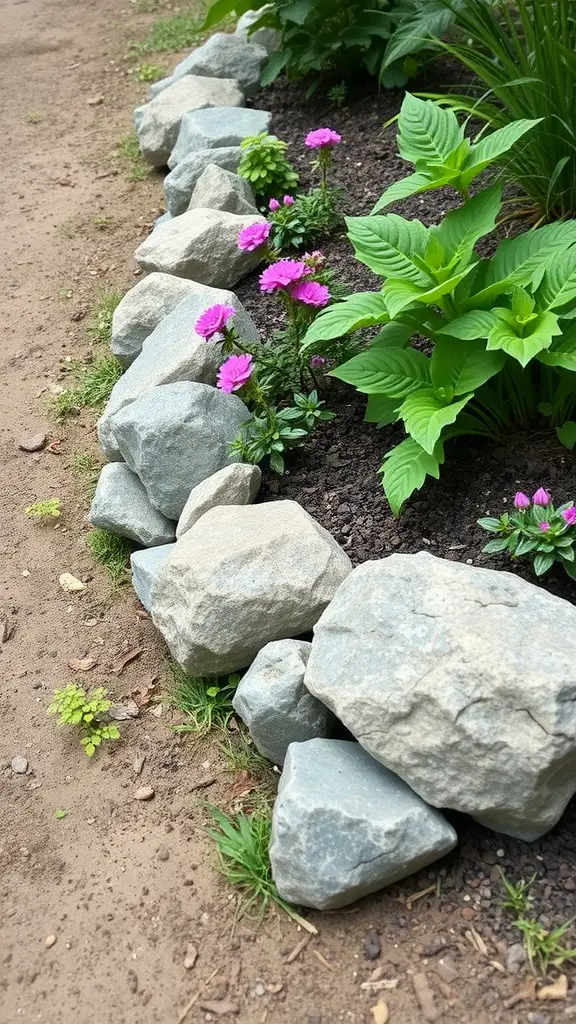
Rocks can work wonders in your garden. They not only add texture but also create a clear definition between different areas. In the image, large, smooth stones form a neat border around vibrant pink flowers and lush green plants.
The way the rocks are arranged gives a natural look. This style complements the greenery, making the flowers pop even more. A border like this helps to keep soil in place and can prevent grass from creeping into flower beds.
Using large rocks can also minimize maintenance. They create a sturdy edge that can withstand weather and foot traffic. Plus, they blend beautifully with the earth, providing a rustic charm.
Think about layering the rocks for an even more dynamic look. Using various sizes and shapes can add visual interest. This simple touch can transform a garden into a cozy retreat.
Creating Dramatic Pathways with Large Rocks
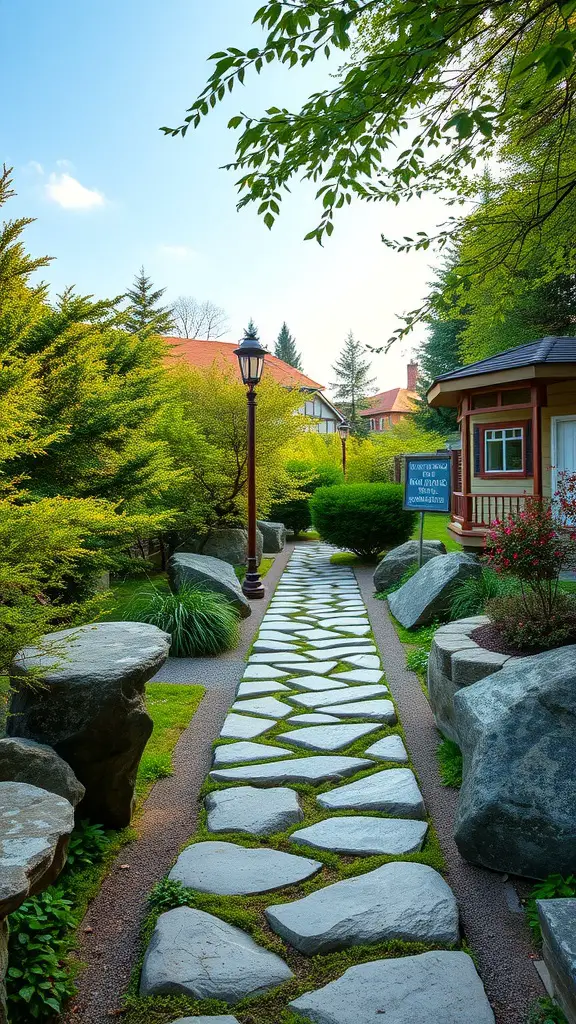
Dramatic pathways can add a distinctive touch to any garden. Using large rocks creates a sturdy and natural look that blends seamlessly with greenery. In the image, a stone path winds through lush plants, making the journey feel inviting.
The stones are placed strategically, guiding visitors along the route. This design encourages exploration and connects different areas of the landscape. The mix of large rocks and smaller plants adds texture and depth, making the pathway visually appealing.
Incorporating lighting, like the lantern seen in the image, can enhance the atmosphere in the evening. It not only illuminates the path but also highlights the beauty of the stones. Overall, using large rocks for pathways is a fantastic way to create a dramatic yet functional feature in your garden.
Emphasizing Natural Terrain with Large Stones
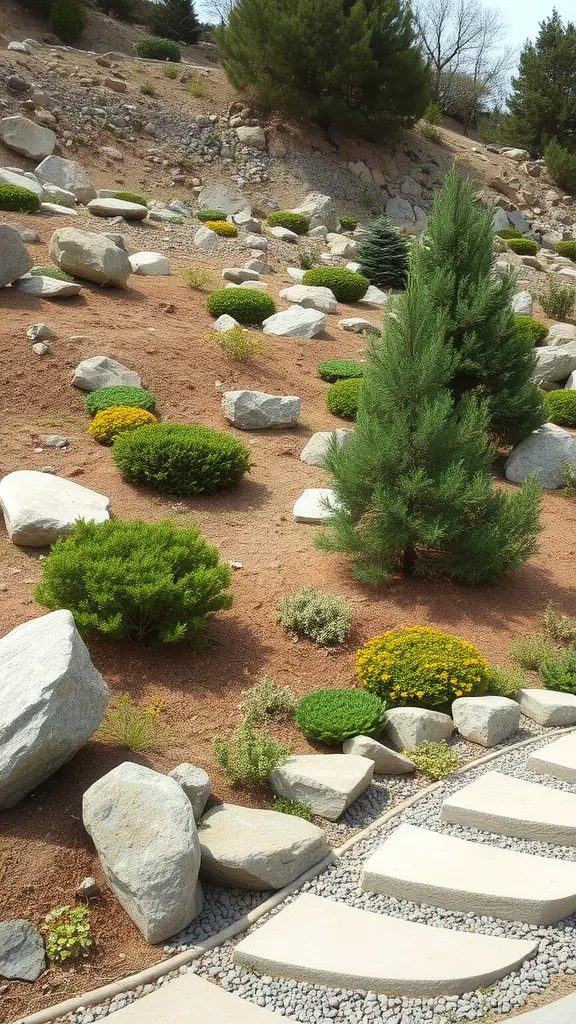
Using large rocks in landscaping can create a rugged and natural look. The image showcases a hillside adorned with big stones and lush greenery. This combination enhances the terrain’s natural beauty while providing structure.
The varying sizes of the rocks add depth to the landscape. They break up the flatness, making the area visually interesting. The arrangement of these stones alongside small bushes and flowers shows how nature can harmonize with design.
A pathway meanders through the scene, leading the eye and inviting exploration. Stepping stones provide a practical way to navigate the garden. The soft earth tones of the rocks blend well with the colorful plants, creating a cohesive look.
Incorporating large stones not only emphasizes the natural environment but also offers a low-maintenance option for landscaping. Once placed, these stones need little care, allowing your garden to thrive with minimal effort.
Enhancing Water Features with Stone Accents

Water features are a wonderful addition to any landscape. When you pair these features with large rocks, the effect can be stunning. The image shows a serene pond surrounded by various sizes of stones and lush greenery.
The large rocks create a natural border, framing the water while adding texture and interest. They soften the lines of the water, making it look inviting and peaceful. The gentle flow of water can be enhanced with the right placement of stones.
Plants like water lilies peek through the surface, adding color and life to the scene. This kind of setup not only beautifies your garden but can also attract wildlife, making it a dynamic spot.
Whether you choose smooth stones or rugged boulders, each type can change the feel of your space. Large rocks can also aid in water filtration if placed strategically, keeping your feature clean and clear.
Incorporating Boulders as Focal Points

Boulders can truly transform any landscape by acting as stunning focal points. Imagine a large granite rock standing tall amidst a vibrant sea of flowers. In the image, you can see how the boulder creates a natural centerpiece, surrounded by colorful blooms that add life to the setting.
This arrangement gives a relaxed, organic feel to the space. The rock’s texture contrasts beautifully with the delicate petals of the flowers. It creates an inviting atmosphere that draws the eye. This kind of setup works well in gardens, parks, or even backyard landscapes.
When choosing boulders, think about their size and shape. A large, smooth boulder can provide a calm, minimalistic look, while a jagged, rough stone might add character and rugged charm. Positioning these rocks near lively flowerbeds can enhance their impact, making the entire area feel cohesive and balanced.
Incorporating boulders in your landscape design is not just about aesthetics; it’s about creating a sense of place. Each boulder tells a story and adds depth to your outdoor space. So, next time you plan a garden project, consider adding a boulder as your highlight. It might just become the star of your landscape.
Building Natural Stone Retaining Walls

Natural stone retaining walls add both functionality and charm to your landscaping. The wall in the image showcases a well-constructed design that provides support while enhancing the overall look of the garden.
The stones used are varied in shape and size, creating a rustic yet cohesive appearance. This natural look blends seamlessly with the surrounding greenery, making it feel like a part of the landscape rather than an added structure.
These walls serve multiple purposes. They help manage soil erosion by holding back earth on sloped areas, preventing runoff during heavy rains. Additionally, they provide a defined border for planting beds, allowing you to create distinct garden zones.
Incorporating plants around the wall, as seen in the image, is a great way to soften the edges. The greenery contrasts beautifully against the stones, adding life and color. You can select a variety of plants to thrive in different conditions, whether in shade or sun.
Building a stone retaining wall requires planning and careful execution. It’s essential to ensure proper drainage and stability to avoid future issues. With the right approach, you can enjoy a stunning and functional addition to your garden.
Planting Succulents Among Stony Landscapes
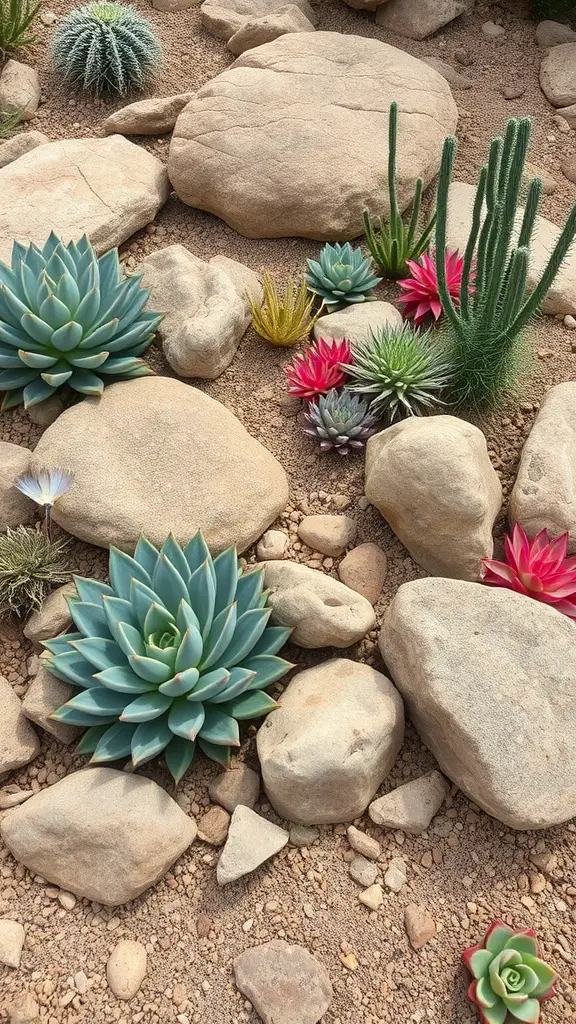
Using large rocks in your landscaping can create a striking setting for planting succulents. The natural combination of stones and vibrant plants brings a unique look to any outdoor space.
In the image, you can see various succulents positioned among smooth stones. The colors of the plants range from shades of green to pink and yellow, adding life to the rocky terrain. This mix makes for an eye-catching display.
Succulents are perfect for this kind of arrangement. They thrive in well-drained soil and require less water, making them great for dry, stony areas. The rocks not only enhance the visual appeal but also help with drainage.
To get started, choose a variety of succulents in different shapes and colors. You can arrange them around the rocks for a natural look. Remember to leave space between the plants to allow them to grow.
Incorporating large rocks and succulents creates a low-maintenance, beautiful landscape that can be enjoyed year-round. So, grab some plants and rocks and get creative!
Creating Zen Gardens with Large Rocks
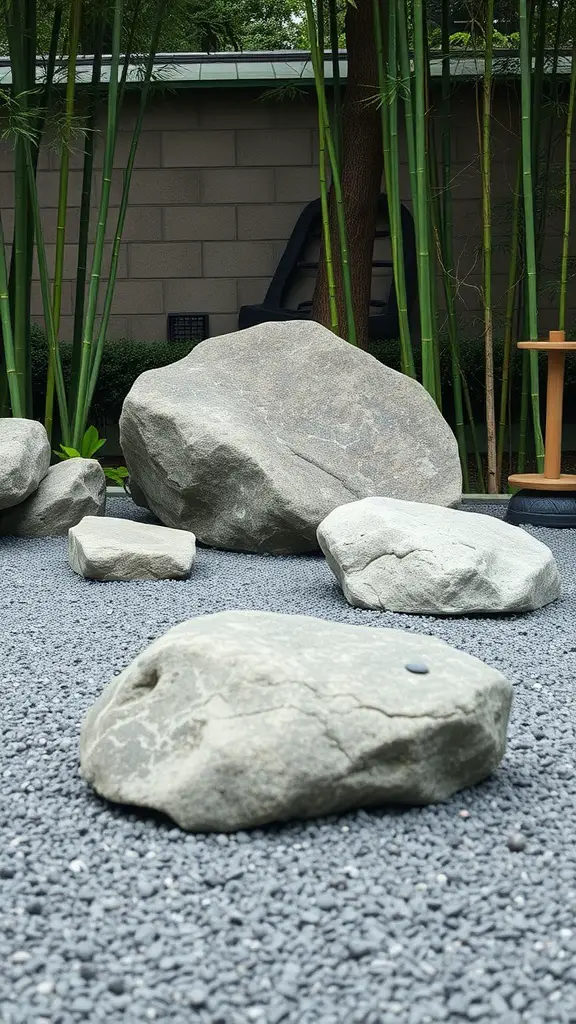
Zen gardens are all about simplicity and tranquility. Using large rocks in your design can create a stunning focal point. The image shows a beautiful arrangement of various-sized stones surrounded by fine gravel. This setup not only looks great, it also promotes a peaceful atmosphere.
The rocks can be placed thoughtfully to guide the eye and encourage exploration in the garden. In this case, the larger stones provide a strong presence, while the smaller ones lead the way. The surrounding greenery adds to the serene vibe, making it an ideal spot for relaxation.
When designing your Zen garden, consider the placement of each rock. Think about balance and how each element interacts with others. Large rocks can symbolize strength and permanence, making them an essential part of the Zen experience.
Crafting Stone Steps for Elevated Gardens

Creating stone steps for an elevated garden can truly enhance its charm. The image showcases a beautifully designed set of stone steps that lead up through vibrant flowers and lush greenery. Each step is crafted from large rocks, giving a natural and sturdy appearance.
These steps not only provide access to different levels of the garden but also add an element of style. The surrounding plants in bright pots bring color and life to the space, making it feel welcoming. It’s easy to see how this design encourages visitors to explore.
Adding stone steps like these can also help with drainage, reducing erosion while adding texture to the landscape. When planning your garden, consider how steps can connect various areas and enhance the overall beauty.
Creating a Rustic Fire Pit with Large Rocks
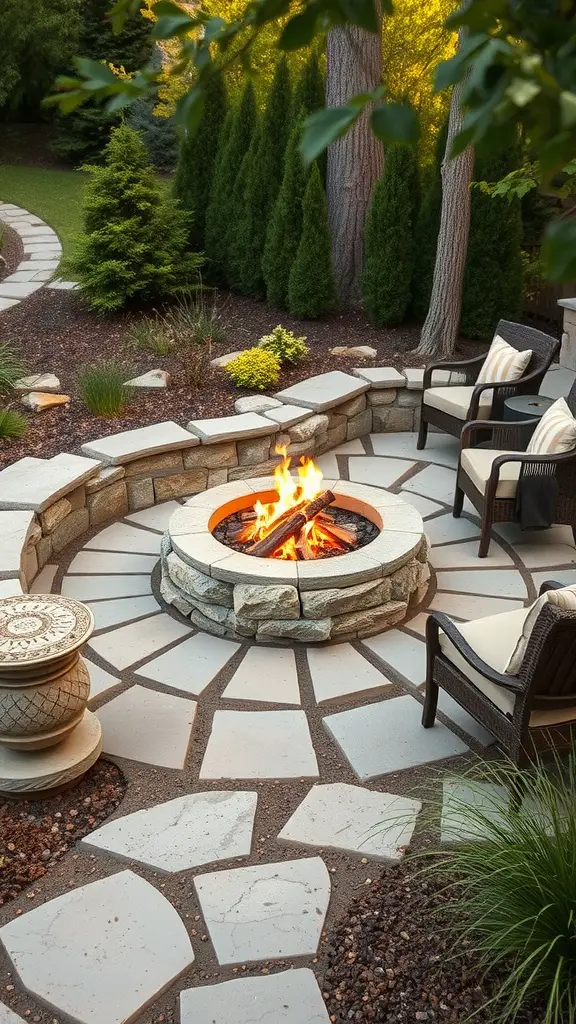
Building a rustic fire pit with large rocks can transform your outdoor space. Imagine gathering around a cozy fire, surrounded by nature, while enjoying the warmth and glow. The image showcases a beautiful fire pit made of sturdy stones, which adds character to the setting. Large rocks not only provide a solid structure, but they also blend seamlessly into the landscape.
The design features a circular fire pit, centrally located, making it an inviting spot for family and friends. Comfortable chairs sit nearby, encouraging relaxation and conversation. The stone pathway adds charm, guiding guests to the fire pit while enhancing the natural vibe.
Adding greenery around the fire pit brings life to the area. The tall trees and shrubs create a sense of privacy and tranquility. This design is perfect for hosting gatherings or simply enjoying peaceful evenings outdoors.
Utilizing Rocky Outcrops for Wildlife Habitats
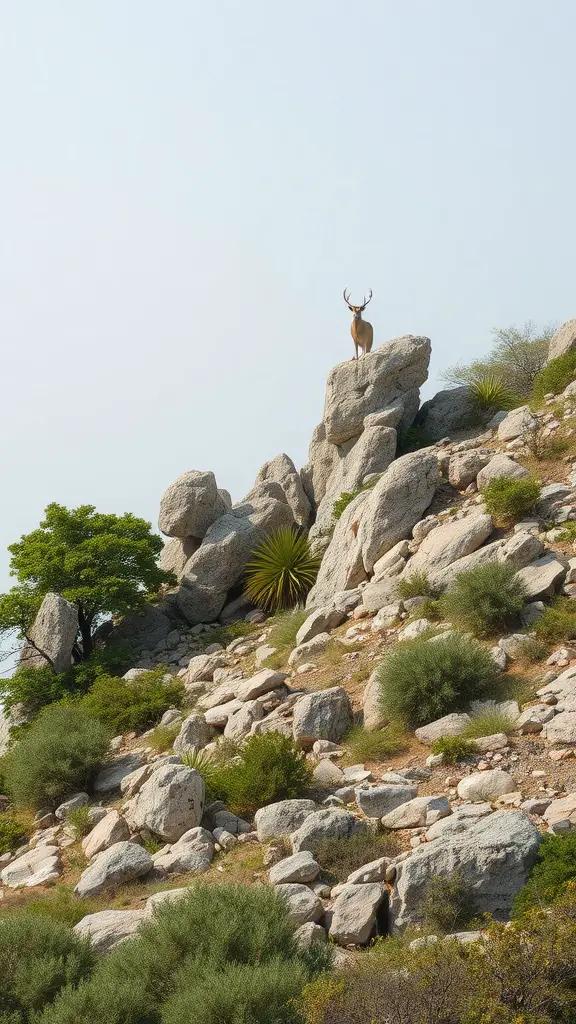
Rocky outcrops are more than just beautiful scenery; they offer unique habitats for various wildlife. In the image, a deer stands proudly atop a rocky formation, showcasing how these natural structures create safe spaces for animals. The elevation provides a vantage point, allowing the deer to observe its surroundings.
These rocky areas are often rich in plant life, supporting a variety of flora. The combination of rocks and vegetation creates a balanced ecosystem. Animals can find shelter from predators and harsh weather while having access to food sources. It’s a win-win for both wildlife and nature enthusiasts.
Integrating rocky outcrops into your landscape not only enhances visual interest but also contributes to local biodiversity. These features can attract birds, insects, and other small creatures, making your garden a lively hub of activity. By embracing these natural formations, you help foster a thriving environment for wildlife.
Integrating Large Rocks into Modern Designs
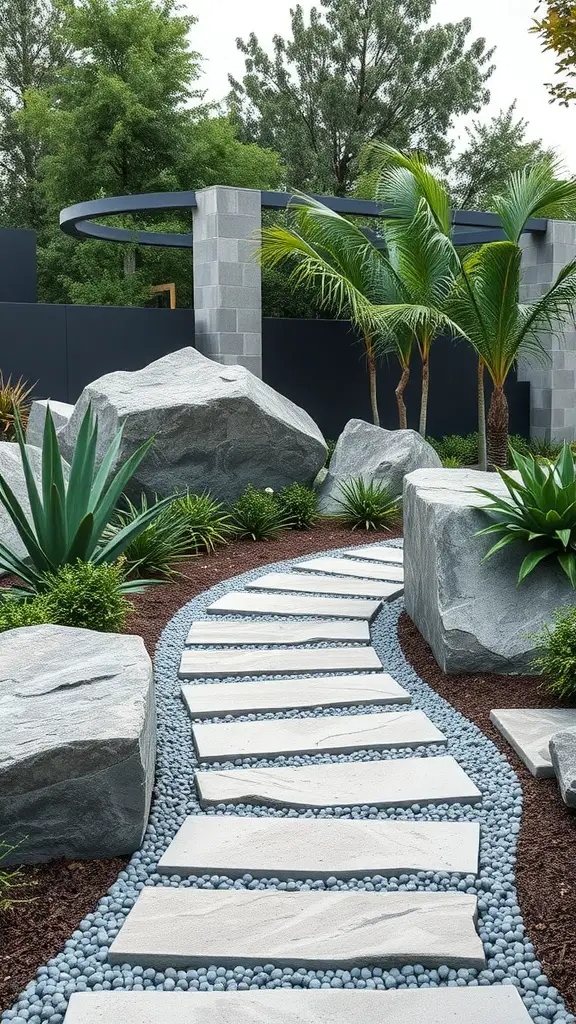
Large rocks can bring a unique charm to modern landscaping. The image showcases a beautifully designed pathway winding through a garden, featuring substantial rocks and a variety of plants. This combination creates a striking visual appeal.
The use of large rocks adds texture and depth to the landscape. They serve as natural focal points that draw the eye and encourage exploration. In this design, the rocks are placed strategically, complementing the smooth stone pathway and enhancing the overall layout.
Incorporating plants like palms and succulents next to these rocks softens their rugged appearance. This combination creates a harmonious balance that feels both inviting and serene. The contrast between the hard surfaces of the rocks and the lush greenery adds to the modern aesthetic.
Designing Edible Landscapes with Rock Features
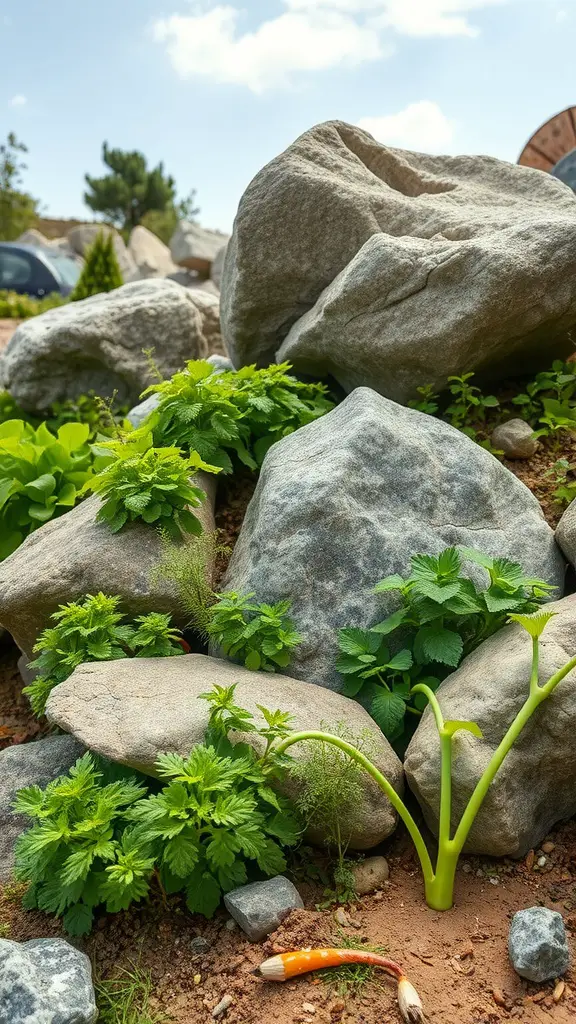
Incorporating large rocks into your edible landscape can create a stunning visual appeal. The image shows a beautiful arrangement of rocks surrounded by a variety of vibrant plants. This setup not only looks great but also serves practical purposes.
The rocks help with drainage and can provide warmth to the soil, benefiting the plants around them. In the image, you can spot herbs and leafy greens, which thrive in such environments. This combination of rocks and edible plants encourages biodiversity and attracts pollinators.
Using rocks in your garden can also create unique microclimates. Some plants prefer more sun, while others thrive in shade. Placing rocks strategically allows you to cater to different plant needs. As shown in the image, a mix of textures and colors from the rocks and plants creates an inviting space.
Don’t forget to consider the maintenance aspect. Edible landscapes with rock features can reduce the need for weeding and watering. The rocks keep the soil cooler and retain moisture, making your garden more sustainable. Try adding a variety of herbs or vegetables in between the rocks for a lush look and easier access for harvesting.
Enhancing Slope Stability with Boulder Placement

Using boulders in landscaping can do wonders for slope stability. The image shows a thoughtfully designed space where large rocks are strategically placed among the greenery. These boulders help prevent soil erosion, especially in areas where the ground is sloped.
The arrangement of rocks not only creates a sense of balance but also enhances the visual appeal of the landscape. In this scene, you can see various sizes of rocks scattered around, providing a natural look while contributing to the overall stability.
Planting grass and flowers near the boulders adds color and life to the area. This combination of rock placement and plant life is effective in maintaining the integrity of the slope while also making it look inviting.
When considering boulders for your landscape, think about their placement. A well-placed boulder can act as a natural barrier against the elements, helping to hold soil in place. These rocks can also create interesting focal points in your garden, adding depth and texture.
Creating Natural Seating Areas with Stones
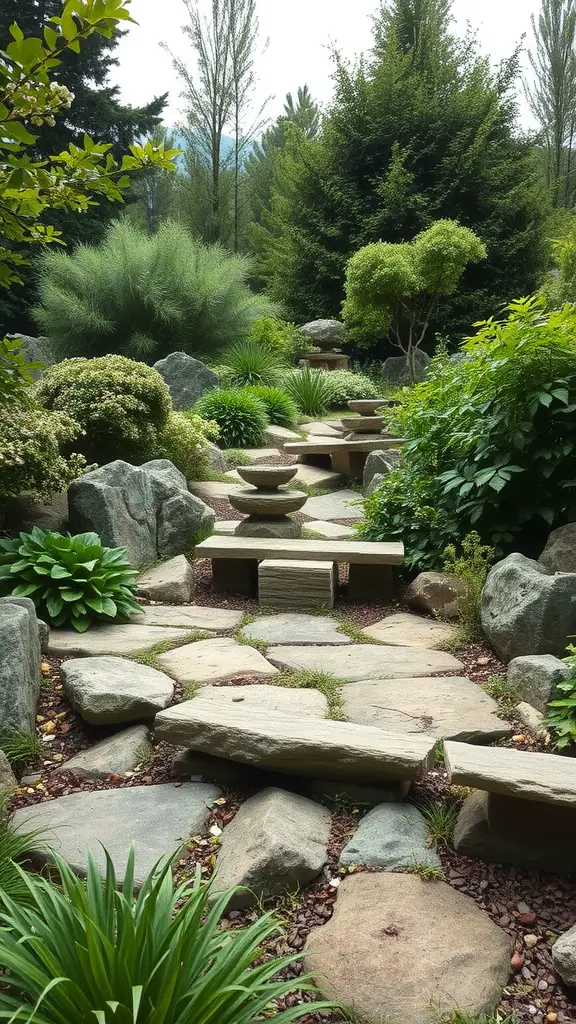
Using large rocks in landscaping can create stunning natural seating areas. The image shows a beautiful path lined with various stones, leading to a cozy seating spot. This setup invites relaxation and connection with nature.
The stone benches blend seamlessly with the surroundings. They provide a rustic charm that enhances the garden’s overall look. Surrounding plants add color and texture, making the space feel alive.
Natural seating areas like this are perfect for gatherings or quiet moments alone. Imagine enjoying a book or sipping coffee while surrounded by greenery. It’s an easy way to make your outdoor space more inviting and functional.




